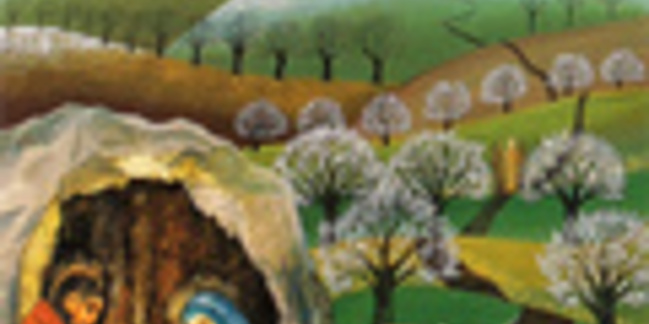 |
Loginoder neu registrieren? |
|||||
              
| ||||||
SucheSuchen Sie im kath.net Archiv in über 70000 Artikeln:     Top-15meist-diskutiert
|  The Manger and the Cross - Calvary Begins in Bethlehem20. Dezember 2011 in English, keine Lesermeinung Advent Reflection: All the events surrounding His birth reveal to us how closely life and death, Christmas and Easter, Bethlehem and Golgotha, Manger and Cross are bound together. Indeed, Calvary begins in Bethlehem. By Fr. Bernhard Speringer ORC Goldlach (kath.net/Catholic Online) During the Advent season we are called to prepare ourselves for the coming of our Redeemer Jesus Christ by prayer, penitence and joyful expectation as well as by meditating on the Christmas Mystery. When we contemplate the ultimate consequence of His Incarnation in poverty and need, interesting aspects arise which make us grow in faith, deepen our love and especially lead us to a great gratitude towards God. On the day after Christmas the Church celebrates the first martyr, the holy deacon Stephen. He was the first in Church history to lay down his life for the sake of his faith, for Christ. Three days after the Solemnity of the Nativity of our Lord and Redeemer we celebrate the feast of the "Holy Innocents", the victims of the infanticide in Bethlehem. St. Augustine and numerous Fathers of the Church praised and venerated the infant martyrs.
Already this temporal sequence makes us aware how closely life and death, Christmas and Easter, Bethlehem and Golgotha, the Manger and the Cross are bound together. INCARNATION AND REDEMPTION The "Passio Domini", the passion of our Lord is not limited to the three paschal days, from the passion of our Lord from the Mount of Olives until the death on the Cross. In the widest sense the Passion of the Lord really begins with the Incarnation. Do we not contemplate in Advent season the "Coming of the LORD in His lowliness"? Do we not contemplate the infinite condescension and humiliation of the LORD, the Creator's SON, GOD's SON, who did not shrink back from becoming man? Is not the search for shelter a way of the Cross for the LORD, who is suffering as He comes into what is his own , but his own people did not receive Him? Is Bethlehem not a Mount of Olives as well, where the LORD and in a special way Mary and Joseph as well suffered an agony, as they were not able to find a lodging for the SON of GOD who was entrusted to them? The Passion of the LORD began with the Incarnation and continues by way of the refusal of the Messiah in Bethlehem and his birth in a cold, dirty stable; by way of the prophesy of Simeon and the flight before Herod to Egypt until to the last chapter of this Passion - the death on the Cross. The birth and death of the Redeemer, one could say: "Manger and Cross", are most closely connected! Born in the wood of the Manger, normally already constructed in the form of a cross - the LORD died on another wood, the wood of the Cross - and all this because of the sin which was committed at the wood of the tree of knowledge in the Paradise. There is not only a science of the Cross (cf. Edith Stein), but also a science of the Manger. "Lord, by Your birth you delivered Yourself also to death, in Your manger You felt and experienced the wood of the Cross for the first time, and your first sobbing as a child rose up before the Face of the Father. Thus Your redemptive passion began." MANGER AND CROSS On a stone drawing by Wilhelm Geyer of the stable of Bethlehem only a part of the tim-berwork remains. It stands above the Child and his Mother raised up like a threatening Cross. The longer one looks at this picture, the more the Child and his Mother withdraw into the background. Surely the two persons constitute the center of the picture. But ever stronger the gallows-like beams protrude and determine the meaning of the image of the birth of CHRIST that the artist wants to give. And from the artist Beate Heinen a picture originates with the title "Manger and Cross". In the foreground one sees a rock cave with the newborn Child Jesus - not in a kind of manger, but in a kind of trough looking like a coffin. From the manger a way starts through a blooming garden. Along the way the trees become more and more bare, the colors more gloomy. At the rear edge of the image a hill with three crosses can be perceived. The way is winding upwards; it is steep. Nothing is growing there any more. There is no green, only grey. It is not a place of life, but of death. We know the name of the hill: ... Foto: Beate Heinen, Krippe und Kreuz (Manger and Cross): Lied: Becky Van Volkinburg, Cradle and the Cross Lied: Hallerin H. Hill, The Cross Is My Christmas Tree The text in German: P. Bernhard Speringer ORC: Die letzte Konsequenz der Menschwerdung Gottes Foto: Beate Heinen, Krippe und Kreuz © Beate Heinen/Schweizerisches Katholisches Sonntagsblatt Ihnen hat der Artikel gefallen? Bitte helfen Sie kath.net und spenden Sie jetzt via Überweisung oder Kreditkarte/Paypal!  LesermeinungenUm selbst Kommentare verfassen zu können müssen Sie sich bitte einloggen. Für die Kommentiermöglichkeit von kath.net-Artikeln müssen Sie sich bei kathLogin registrieren. Die Kommentare werden von Moderatoren stichprobenartig überprüft und freigeschaltet. Ein Anrecht auf Freischaltung besteht nicht. Ein Kommentar ist auf 1000 Zeichen beschränkt. Die Kommentare geben nicht notwendigerweise die Meinung der Redaktion wieder. |  Mehr zuAdvent
|       Top-15meist-gelesen
| |||
 | ||||||
© 2026 kath.net | Impressum | Datenschutz | ||||||



